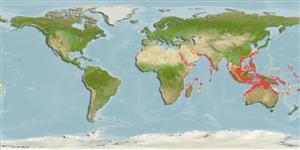>
Eupercaria/misc (Various families in series Eupercaria) >
Lethrinidae (Emperors or scavengers) > Lethrininae
Etymology: Lethrinus: Greek, lethrinia, a fish pertaining to genus Pagellus.
More on author: Valenciennes.
Environment: milieu / climate zone / depth range / distribution range
Ecologie
marien rifbewoner; standvastig; diepte 1 - 150 m (Ref. 4369). Tropical; 30°N - 35°S, 24°E - 173°W
Indo-West Pacific: Red Sea and East Africa to the Ryukyu Islands and New Caledonia. Recently reported from Tonga (Ref. 53797). Also reported from French Polynesian islands (Ref. 4795) but this is a misidentification of Lethrinus rubrioperculatus (Ref. 2295).
Grootte / Gewicht / Leeftijd
Maturity: Lm ? range ? - ? cm
Max length : 20.0 cm TL mannelijk / geslacht onbekend; (Ref. 2295); max. gerapporteerde leeftijd: 15 Jaren (Ref. 2290)
Dorsale stekels (totaal) : 10; Dorsale zachte stralen (totaal) : 9; Anale stekels: 3; Anale zachte stralen: 8. Body is brown and gray (usually green, Ref. 48635), becoming lighter ventrally, with scattered irregular dark spots. Often there are two dark bands below the eye, one at the lower rim or the opercle and one at the corner of the mouth. The fins are generally light or translucent; the caudal fin is light and dark striped.
Inhabits sandy and weedy areas near coral reefs, solitarily or in groups (Ref. 30573, 90102), where it is well camouflaged and usually swims in the cover of the substrate (Ref. 48635). Juveniles sometimes abundant in shallow, weedy areas (Ref. 4369). Solitary or in small groups (Ref. 90102). Feeds on small benthic invertebrates (Ref. 30573). A protogynous hermaphrodite (Ref. 55367). Flesh of large individuals is esteemed (Ref. 4369).
Levenscyclus en paargedrag
Maturiteit | Voortplanting | Paaien | Eieren | Fecunditeit | Larven
A monandric species (Ref. 55367). Length at sex change = 29.1 cm TL (Ref. 55367). Also Ref. 103751.
Carpenter, K.E. and G.R. Allen, 1989. FAO Species Catalogue. Vol. 9. Emperor fishes and large-eye breams of the world (family Lethrinidae). An annotated and illustrated catalogue of lethrinid species known to date. FAO Fish. Synop. 125(9):118 p. Rome: FAO. (Ref. 2295)
Status op de Rode Lijst van het IUCN (Ref. 130435: Version 2024-2)
Gevaar voor de mens
Harmless
Gebruik door de mens
Visserij: van minder commercieel belang
Tools
Speciale rapporten
Download XML
Internetbronnen
Estimates based on models
Preferred temperature (Ref.
123201): 24.2 - 29, mean 27.9 °C (based on 1950 cells).
Fylogenetische diversiteitsindex (Ref.
82804): PD
50 = 0.5000 [Uniqueness, from 0.5 = low to 2.0 = high].
Bayesian length-weight: a=0.01479 (0.00699 - 0.03129), b=2.98 (2.81 - 3.15), in cm total length, based on LWR estimates for this Genus-body shape (Ref.
93245).
Trofisch niveau (Ref.
69278): 3.8 ±0.0 se; based on diet studies.
Generation time: 2.2 ( na - na) years. Estimated as median ln(3)/K based on 1
growth studies.
Weerstandsvermogen (Ref.
120179): Gemiddeld, minimale populatieverdubbelingstijd 1,4-4,4 jaar (K=0.49; tmax=15).
Fishing Vulnerability (Ref.
59153): Low vulnerability (10 of 100).
Nutrients (Ref.
124155): Calcium = 68.3 [47.0, 105.2] mg/100g; Iron = 0.968 [0.647, 1.427] mg/100g; Protein = 20 [17, 22] %; Omega3 = 0.168 [0.114, 0.243] g/100g; Selenium = 40.8 [25.8, 68.1] μg/100g; VitaminA = 49.5 [10.5, 270.8] μg/100g; Zinc = 2.54 [1.99, 3.27] mg/100g (wet weight); based on
nutrient studies.
